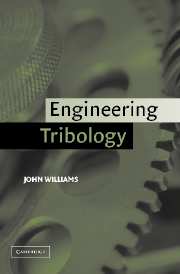Book contents
- Frontmatter
- Preface
- Contents
- Nomenclature
- 1 Introduction
- 2 Engineering surfaces
- 3 Contact between surfaces
- 4 The friction of solids
- 5 Wear and surface damage
- 6 Hydrostatic bearings
- 7 Hydrodynamic bearings
- 8 Gas bearings, non-Newtonian fluids, and elasto-hydrodynamic lubrication
- 9 Boundary lubrication and friction
- 10 Dry and marginally lubricated contacts
- 11 Rolling contacts and rolling-element bearings
- Problems
- Answers to problems
- Appendices
- Author index
- Subject index
8 - Gas bearings, non-Newtonian fluids, and elasto-hydrodynamic lubrication
Published online by Cambridge University Press: 05 June 2012
- Frontmatter
- Preface
- Contents
- Nomenclature
- 1 Introduction
- 2 Engineering surfaces
- 3 Contact between surfaces
- 4 The friction of solids
- 5 Wear and surface damage
- 6 Hydrostatic bearings
- 7 Hydrodynamic bearings
- 8 Gas bearings, non-Newtonian fluids, and elasto-hydrodynamic lubrication
- 9 Boundary lubrication and friction
- 10 Dry and marginally lubricated contacts
- 11 Rolling contacts and rolling-element bearings
- Problems
- Answers to problems
- Appendices
- Author index
- Subject index
Summary
Introduction
All real materials possess some microstructure which becomes apparent when a representative specimen is viewed with a sufficient degree of magnification. However, engineers usually work at a comparatively large scale and so use macroscopic models of material behaviour: these are likely to involve a very large number of the individual microstructural units which contribute to the overall material response. Engineering properties of the bulk represent average or integrated values, and when dealing with either solids or liquids the material is often treated as a homogeneous continuum. In the case of the linear elastic theory of solids what is required is Hooke's law and the observation that most metals undergo only a very small strain before yielding. Similarly, a Newtonian compressible fluid is described by the linear relationships between the applied shear stress and the resultant shear strain rate, and between density and the applied hydrostatic pressure. Many liquid lubricants, including hydrocarbon mineral oils, are effectively incompressible at moderate pressures so that their density remains constant, and this simplifies the analysis still further.
There is no fundamental reason why the lubricant in a hydrodynamic bearing should not be a vapour or a gas (rather than a liquid such as oil or water); indeed considered as a potential lubricant, air has a number of advantages–such as cleanliness and ease of supply–and it has been used in aerostatic and aerodynamic bearings for several decades.
- Type
- Chapter
- Information
- Engineering Tribology , pp. 301 - 347Publisher: Cambridge University PressPrint publication year: 2005

